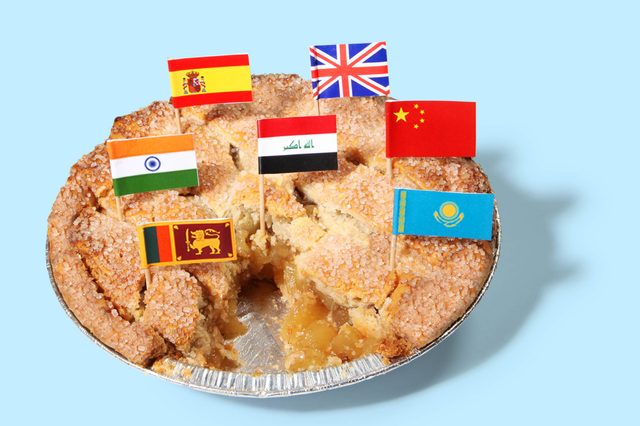This Is How Apple Pie Became America’s Favorite Dessert
Updated: Oct. 26, 2022
Turns out that none of the ingredients in our favorite dessert are native to the United States. Yet history made it ours. How?

The grill glows hot, the beer is on ice, and the fireworks are ready to burst. There are burgers, potato salad, and, of course, apple pie. But this all-American dessert isn’t as homegrown as you’d think. “Not one ingredient in apple pie originates from what we call the United States,” says Libby O’Connell, author of The American Plate: A Culinary History in 100 Bites. So what’s the lineage of this seemingly domestic delight? Chew on this:
The recipe
The British used animal fat, wheat, and water to create airtight pastry shells with the unappetizing name of “coffyns.” These savories were usually stuffed with beef or venison. In America, the shells became flakier (like the strudels made by German immigrants) and the meat fillings were replaced with apples, a way to use up imperfect fruit.
Apples
The sweet, juicy fruit we use in pie isn’t native to North America, which specializes in crab apples. It originated in Kazakhstan. The Romans then crossed it with astringent apples used for making cider. (True tidbit: Johnny “Appleseed” Chapman really did plant orchards around the United States.) Love apples? Here are some other healthy ways to eat apples you didn’t know about.
Wheat
First cultivated more than 9,000 years ago, ancient wheat has been found in Iraq, Iran, and throughout the Middle East. The “king of grains” spread through Europe and then to the New World, where it failed miserably, which is why colonists relied on a Native American staple for baking: corn. In the late 1800s, Russian immigrants brought a wheat variety known as Turkey Red, which was better suited to our climate.
Lard and Butter
Wild boars (the ancestors of lard-producing pigs) are native to Asia, Europe, and Africa. It was actually Christopher Columbus, on his second voyage to the New World in 1493, who brought pigs and cattle, the source of all things dairy.
Sugar and Spices
Columbus also played deliveryman for sugar, which originated about 4,000 years ago in Indonesia, India, China, and what is now Papua New Guinea. Cinnamon comes from an evergreen tree native to Sri Lanka. (The prophet Moses and Rome’s emperor Nero are believed to have eaten it.) The variety most commonly found on supermarket shelves today is cassia cinnamon, which originated in southern China. Cloves and nutmeg, indigenous to the Banda Islands of Indonesia, were considered so precious that Ferdinand Magellan brought 50 tons of them back to Spain after he sailed around the world in 1522. Watch out for these foods that are surprisingly high in sugar.
Becoming an American “Original”
Once all the ingredients were in place, putting them together was as easy as—Well, it wasn’t so easy after all. Although the earliest apple pie recipes date to the 1300s, it took nearly 500 years for the dessert to hit it big in the United States. “During the Civil War, both Union and Confederate troops scavenged for apples and commandeered the hearths—and flour bins—of white farmers and black tenants to bake pies,” writes John T. Edge in Apple Pie: An American Story. “Wartime adversity fixed the taste of apple pie on the palate of generations to come.” By 1902, an editorial in the New York Times proclaimed that pie had become “the American synonym for prosperity.” In the 1920s, the phrase as American as apple pie started to appear in print, and by World War II, soldiers declared that they were fighting “for mom and apple pie.” Apple pie—wholesome and comforting—had woven itself into the way we see our country.
Originally published on NPR July 3, 2016.